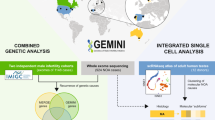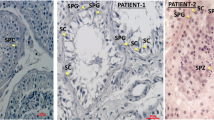Abstract
The World Health Organization conservatively estimates that 80 million people suffer from infertility worldwide. Male factors are believed to be responsible for 20–50% of all infertility cases, but microdeletions of the Y chromosome are the only genetic defects altering human spermatogenesis that have been reported repeatedly1. We focused our work on infertile men with a normal somatic karyotype but typical spermatozoa mainly characterized by large heads, a variable number of tails and an increased chromosomal content (OMIM 243060)2,3,4. We performed a genome-wide microsatellite scan on ten infertile men presenting this characteristic phenotype. In all of these men, we identified a common region of homozygosity harboring the aurora kinase C gene (AURKC) with a single nucleotide deletion in the AURKC coding sequence. In addition, we show that this founder mutation results in premature termination of translation, yielding a truncated protein that lacks the kinase domain. We conclude that the absence of AURKC causes male infertility owing to the production of large-headed multiflagellar polyploid spermatozoa.
This is a preview of subscription content, access via your institution
Access options
Subscribe to this journal
Receive 12 print issues and online access
$209.00 per year
only $17.42 per issue
Buy this article
- Purchase on Springer Link
- Instant access to full article PDF
Prices may be subject to local taxes which are calculated during checkout




Similar content being viewed by others
Accession codes
References
Pryor, J.L. et al. Microdeletions in the Y chromosome of infertile men. N. Engl. J. Med. 336, 534–539 (1997).
Nistal, M., Paniagua, R. & Herruzo, A. Multi-tailed spermatozoa in a case with asthenospermia and teratospermia. Virchows Arch. B Cell Pathol. 26, 111–118 (1977).
Escalier, D. Human spermatozoa with large heads and multiple flagella: a quantitative ultrastructural study of 6 cases. Biol. Cell 48, 65–74 (1983).
Escalier, D. Genetic approach to male meiotic division deficiency: the human macronuclear spermatozoa. Mol. Hum. Reprod. 8, 1–7 (2002).
German, J., Rasch, E.M., Huang, C.Y., MacLeod, J. & Imperato-McGinley, J. Human infertility due to production of multiple-tailed spermatozoa with excessive amounts of DNA. Am. J. Hum. Genet. 33, 64A (1981).
Pieters, M.H. et al. Evidence of disturbed meiosis in a man referred for intracytoplasmic sperm injection. Lancet 351, 957 (1998).
Benzacken, B. et al. Familial sperm polyploidy induced by genetic spermatogenesis failure: case report. Hum. Reprod. 16, 2646–2651 (2001).
Devillard, F. et al. Polyploidy in large-headed sperm: FISH study of three cases. Hum. Reprod. 17, 1292–1298 (2002).
In't Veld, P.A. et al. Intracytoplasmic sperm injection (ICSI) and chromosomally abnormal spermatozoa. Hum. Reprod. 12, 752–754 (1997).
Bernard, M., Sanseau, P., Henry, C., Couturier, A. & Prigent, C. Cloning of STK13, a third human protein kinase related to Drosophila aurora and budding yeast Ipl1 that maps on chromosome 19q13.3-ter. Genomics 53, 406–409 (1998).
Kimura, M., Matsuda, Y., Yoshioka, T. & Okano, Y. Cell cycle-dependent expression and centrosome localization of a third human aurora/Ipl1-related protein kinase, AIK3. J. Biol. Chem. 274, 7334–7340 (1999).
Tang, C.J., Chuang, C.K., Hu, H.M. & Tang, T.K. The zinc finger domain of Tzfp binds to the tbs motif located at the upstream flanking region of the Aie1 (aurora-C) kinase gene. J. Biol. Chem. 276, 19631–19639 (2001).
Tang, C.J., Lin, C.Y. & Tang, T.K. Dynamic localization and functional implications of Aurora-C kinase during male mouse meiosis. Dev. Biol. 290, 398–410 (2006).
Kozak, M. Constraints on reinitiation of translation in mammals. Nucleic Acids Res. 29, 5226–5232 (2001).
Bishop, J.D. & Schumacher, J.M. Phosphorylation of the carboxyl terminus of inner centromere protein (INCENP) by the Aurora B Kinase stimulates Aurora B kinase activity. J. Biol. Chem. 277, 27577–27580 (2002).
Honda, R., Korner, R. & Nigg, E.A. Exploring the functional interactions between Aurora B, INCENP, and survivin in mitosis. Mol. Biol. Cell 14, 3325–3341 (2003).
Tatsuka, M. et al. Multinuclearity and increased ploidy caused by overexpression of the aurora- and Ipl1-like midbody-associated protein mitotic kinase in human cancer cells. Cancer Res. 58, 4811–4816 (1998).
Chen, H.L., Tang, C.J., Chen, C.Y. & Tang, T.K. Overexpression of an Aurora-C kinase-deficient mutant disrupts the Aurora-B/INCENP complex and induces polyploidy. J. Biomed. Sci. 12, 297–310 (2005).
Yan, X. et al. Aurora C is directly associated with Survivin and required for cytokinesis. Genes Cells 10, 617–626 (2005).
Sasai, K. et al. Aurora-C kinase is a novel chromosomal passenger protein that can complement Aurora-B kinase function in mitotic cells. Cell Motil. Cytoskeleton 59, 249–263 (2004).
Kimmins, S. et al. Differential functions of the aurora-B and aurora-C kinases in Mammalian spermatogenesis. Mol. Endocrinol. 21, 726–739 (2007).
Yan, X. et al. Cloning and characterization of a novel human Aurora C splicing variant. Biochem. Biophys. Res. Commun. 328, 353–361 (2005).
Assou, S. et al. The human cumulus–oocyte complex gene-expression profile. Hum. Reprod. 21, 1705–1719 (2006).
World Health Organization. WHO Laboratory Manual for the Examination of Human Semen and Sperm–Cervical Mucus Interaction (Cambridge University Press, Cambridge, UK, 1999).
Tseng, T.C., Chen, S.H., Hsu, Y.P. & Tang, T.K. Protein kinase profile of sperm and eggs: cloning and characterization of two novel testis-specific protein kinases (AIE1, AIE2) related to yeast and fly chromosome segregation regulators. DNA Cell Biol. 17, 823–833 (1998).
Herbreteau, C.H. et al. HIV-2 genomic RNA contains a novel type of IRES located downstream of its initiation codon. Nat. Struct. Mol. Biol. 12, 1001–1007 (2005).
Acknowledgements
We thank all affected individuals and family members for their participation. We thank E. Panetto of Applied Imaging for his help with the fluorescent microscopy and O. Amina for technical help. We thank S. Dutertre and C. Prigent (Rennes University) for sending us the AURKC wild-type clone. We thank S. Kimmins for discussion about their knockout animals. We are also grateful to P. Richard (la Pitié Salpétrière, Paris) for providing control DNAs. R.S.R. and T.O. are supported by a grant from the Agence Nationale de la Recherche (ANR). This work was supported in part by the Fondation d'Aide à la Recherche Organon (FARO) and the Direction de la Recherche Clinique (DRC) du CHU de Grenoble.
Author information
Authors and Affiliations
Corresponding author
Ethics declarations
Competing interests
The authors declare no competing financial interests.
Supplementary information
Supplementary Fig. 1
Genotypes of 14 men with large-headed spermatozoa. (PDF 38 kb)
Supplementary Table 1
Sequences of Aurora Kinase C primers. (PDF 48 kb)
Rights and permissions
About this article
Cite this article
Dieterich, K., Soto Rifo, R., Faure, A. et al. Homozygous mutation of AURKC yields large-headed polyploid spermatozoa and causes male infertility. Nat Genet 39, 661–665 (2007). https://doi.org/10.1038/ng2027
Received:
Accepted:
Published:
Issue Date:
DOI: https://doi.org/10.1038/ng2027
This article is cited by
-
Aurora kinase genetic polymorphisms: an association study in Down syndrome and spontaneous abortion
Human Cell (2022)
-
Will whole-genome sequencing become the first-line genetic analysis for male infertility in the near future?
Basic and Clinical Andrology (2021)
-
Purging human ovarian cortex of contaminating leukaemic cells by targeting the mitotic catastrophe signalling pathway
Journal of Assisted Reproduction and Genetics (2021)



